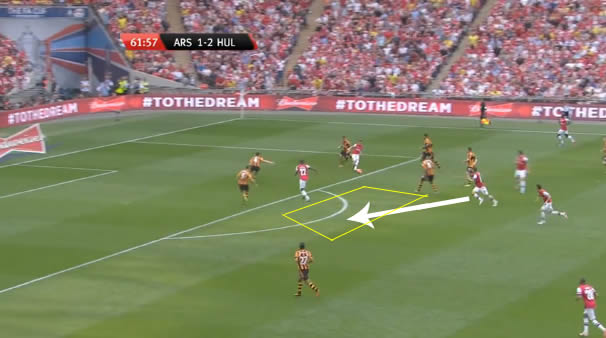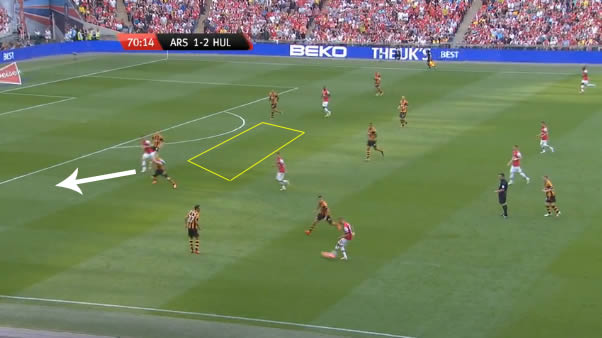So at last he’s gone, the malign monkey that has been on Arsene Wenger’s back jabbering away for these last long nine years about Arsenal’s failure to win a trophy. After ten minutes of the FA Cup final, however, he was resting comfortably, chain-smoking like a simian Zdeněk Zeman as Hull City raced away to a two-goal lead. By the end of normal time he was viciously clawing at Wenger’s shoulders, trying to cling on as Arsenal overturned the deficit and as the final final whistle blew, his energies were exhausted as he was ruthlessly twatted to the floor.
The relief on Wenger’s face was palpable, and this was a win for him as much as the team and the fans. When Thomas Vermaelen lifted the trophy, instead of handing it over to the next players down the line as custom dictates that he should, he gave it to his manager who was standing right by him instead of unobtrusively at the back.
For Arsenal it was a convoluted win, a pulsating encounter of course, but a performance which, in a way, was a tribute act to the past nine years of stasis, borrowing all the frustrations, hope, anguish and ultimately, joy, from the tumultuous period. It was, however, Wenger who really delved back into the past, reverting to a 4-4-2 rarely seen in recent seasons. It was a move which seemed a gamble at first: Arsenal relinquishing control for more firepower but in reality, it was a mix of the old with the new as it allowed their carousel of ball-players to find their “zippy movements to play through the lines.”
Indeed, essentially, this is all what Arsenal’s tactics boils down to. The Gunners moved to a 4-4-2 – complete with two creative midfielders on the flanks circa 2003/04 – but what Arsenal have really been about this season is getting their attacking players to pass the ball incisively to the striker and then quickly play around him. At times it’s been a joy to watch with Olivier Giroud’s neat flicks a crucial part of Arsenal’s play and the midfielders working around him like ants in a colony.
Against Hull, with Yaya Sanogo joining Giroud, it provided Arsenal two players who could get into the space between Hull’s defence and midfield. Indeed, it was the man hauled off to cater for the change, Lukas Podolski, who was given primary responsibility beforehand to try and provide support for Giroud as theoretically Arsenal were outnumbered in that area. Hull City’s 3-5-2 gave Arsenal space on the flanks but their ingenuity was that they funnelled play to the centre where two lines stopped Arsenal from playing.
The Gunners didn’t know how to react for the first 60 minutes with the movement in the final third particularly poor. Mesut Ozil constantly dropped deep to get the ball, Aaron Ramsey tried to push up into that space and generally do everything, while Santi Cazorla kept on coming inside when he might have been better off making the late runs from wide. Lukas Podolski, though, was the easy culprit, because in Wenger’s system, the reason that why he doesn’t often move to a 4-4-2 is that the onus is on one of the wide forwards he deploys. Arsenal had a couple of opportunities to spring Podolski through on goal, once from a Giroud cutback, and another time he managed his trademark cross to the near post which Ozil completely miskicked, but in the main, he was snuffed out, his movement sometimes not much more than just stumbling into the right position at the right time.
Arsenal get snuffed out final-third



Arsenal bring on Sanogo: game stretches



Mikel Arteta explains the work Arsenal do on the training ground to perfect these moves, reaping the rewards in the cup final:
“At Arsenal, we do a lot of exercises where you have to play through the mannequins, but you can use cones. This is a great drill because it’s real; you’re moving and finding the holes to play the diagonal pass, just like in a match… This drill will help you during a game when out to create two versus one situations against a defender. It’s also great for finding the spare man. Think of player two as a midfielder and player three as a full back or winger on the overlap.”
From sixty minutes onwards, with more players to combine with, Arsenal created chance after chance, opening after opening, regularly exchanging one-twos around the box and suddenly changing the emphasis of the attack. When Arsenal needed one more goal, with only one half of extra time remaining, Wenger sought to up the ante, introducing Jack Wilshere and Tomas Rosicky for Cazorla and Ozil, and in one clinical move, the cup was won. Wilshere playing an incisive pass to Sanogo, Giroud back-heeling the ball to Ramsey to prod home. The astonishing thing was there were other chances like this that Arsenal to complete the comeback before Ramsey fittingly provided the winner.
He has been Arsenal’s standout player this season, embodying the best of late Wengerism: skilful, spontaneous and confident in possession – the type of player that makes Arsenal a joy to watch – though left with a little bit of fragility that can occasionally frustrate, before finally coming into glorious maturity. Like the rest of the team, he took a while to get going but once he did, he was at his talismanic best, driving the team forward and playing some fantastic round-the-corner passes.
Initially Arsenal looked scared to play those incisive pass and to turn on the ball, that anxiousness that has been the bane of them in the big matches, raring its ugly head again. But contrary to perception, Arsenal actually made of much stronger stuff, as continually bouncing back out of adverse scenarios requires a different type of courage as is having the faith to keep playing your game. Wenger implored his team keep doing that and though Hull tried to even the playing field by targeting Arsenal’s zonal-marking from set-pieces, The Gunners showed the resilience of seasoned winners.
One hopes it will be the springboard for more glory.


